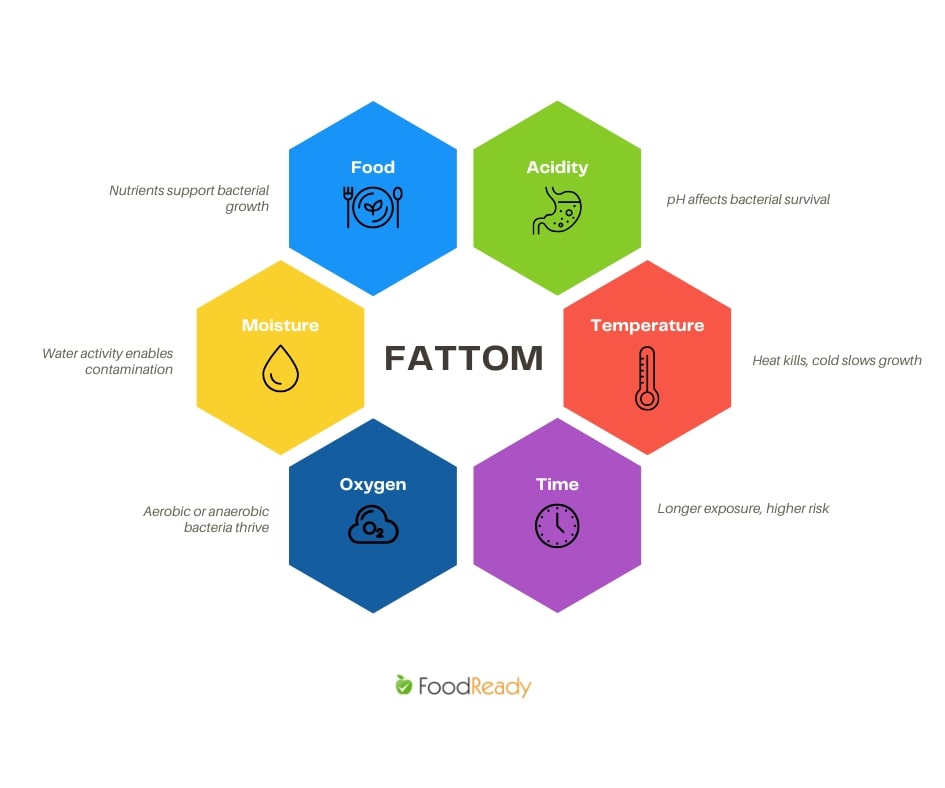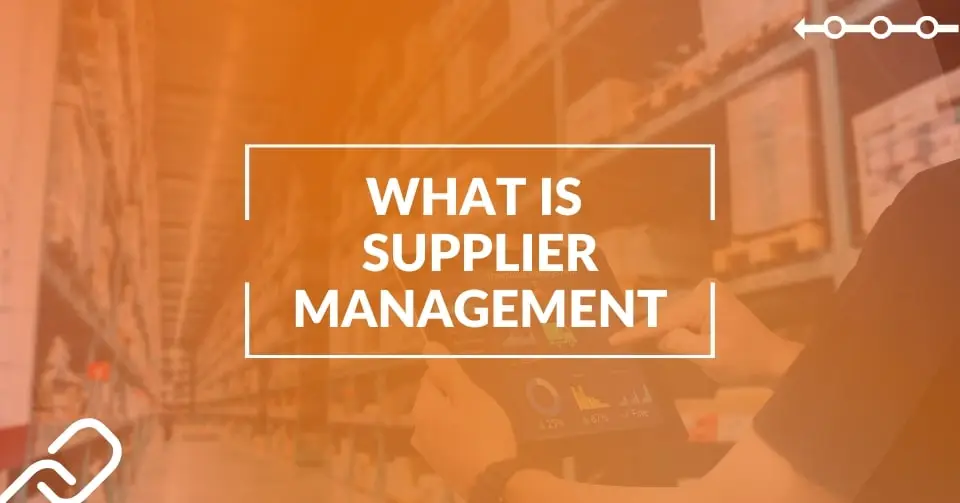The food and beverage industry is full of challenges. One of them is ensuring food safety and contributing to public health – a top priority for a food business. Companies can reach this goal by constantly monitoring and preventing factors that adversely affect customers’ well-being and the brand’s reputation.
Hazardous microorganisms can contaminate food, causing foodborne illnesses, and FATTOM monitoring helps you control bacterial growth to avoid food safety issues.
In this article, you’ll learn about FATTOM factors and understand why they are essential for food safety and compliance.
What Does FATTOM Stand For?
The FATTOM acronym is used in food safety and stands for six factors contributing to the growth of foodborne pathogens. Understanding the peculiarities of FATTOM will help food manufacturers prevent foodborne illness outbreaks and cross-contamination.
Here’s a more detailed look at the meaning and examples of FATTOM:
F – Food
People’s food is also fuel for microorganisms, and food containing carbohydrates or protein provides a suitable environment for them to grow. The more nutritious food is, the more likely bacteria can thrive there—high-protein or carbohydrate foods like meats, poultry, dairy, cooked rice, and pasta are considered high-risk.
For instance, raw chicken can easily be contaminated with Salmonella if not handled properly, which includes separating, adhering to storing and cooking temperatures and other conditions, etc.
A – Acidity
pH level of a product can determine its acidity or alkalinity. The pH scale is from 1 to 14, where less than seven is acidic, above seven is alkaline, and seven is neutral. Bacteria are more likely to grow in neutral or slightly acidic environments.
Low-acidity products like milk, meat, soy, and vegetables are less resistant to pathogens. In contrast, products with higher acidity, such as fresh fruits, preserves, and fermented products, have lower risks of spoilage.
The level of acidity defines the pathogen that can affect a product because different microorganisms thrive in various environments.
T – Temperature
Temperature plays a pivotal role in preventing cross-contamination. It’s essential for cooking and storage: food must be processed under certain temperatures to minimize harmful pathogens and stored in cold conditions so the microorganisms don’t spread.
TCS foods (requiring Time and Temperature Control) are more susceptible to microorganism growth and contamination if they remain in the temperature danger zone (TDZ) between 40°F and 140°F for too long.
For example, unrefrigerated milk is more susceptible to contamination than stored at an appropriate temperature. Or, meat must be cooked to a particular temperature to kill harmful pathogens like E. coli or Salmonella.
T – Time
This one is related to the temperature aspect described above. The minimal accepted amount of bacteria on food is okay; the food can’t be sterile, but if high-risk foods are left in a temperature danger zone between 40°F and 140°F for more than 4 hours, they become unsafe to eat.
That’s why time and temperature monitoring is required when cooking and storing food.
O – Oxygen
Microorganisms either develop or die because of oxygen. Many organisms require air to grow (aerobic), while some bacteria can only survive without oxygen (anaerobic microorganisms perish when exposed to air). For instance, there’s a risk of C. botulinum contamination in improperly canned or vacuum-sealed foods.
Therefore, you must pay attention to controlling oxygen interaction in food and differentiate the products that can potentially get contaminated by aerobic or anaerobic organisms.
M – Moisture
Moisture can influence bacterial growth. Moisture content should be monitored as bacteria require different amounts of water to thrive. Even low-moisture foods are susceptible to contamination. For instance, a Salmonella outbreak in 2023 was caused by a recalled all-purpose flour.

What Is the Role of FATTOM in Food Safety?
A proper approach to FATTOM helps businesses achieve and maintain food safety compliance and prevent foodborne illnesses. Understanding FATTOM allows food manufacturers and handlers to create efficient monitoring procedures, implement appropriate food handling strategies, and avoid food spoilage.
FATTOM factors help deliver quality products, enhancing brand reputation and consumer trust. Food businesses will also save money by preventing contamination and recalls through FATTOM.
Food manufacturers that understand and implement FATTOM factors can boost operational efficiency and productivity growth. Moreover, employee training will become more effective and focused, ensuring that the risks are addressed proactively and efficiently. This approach will help ensure food safety and comply with regulatory standards.
Overall, FATTOM factors can positively and negatively impact the food you produce and your business – it all depends on how you treat them.
How to Handle FATTOM?
We’ve gathered specific and more general information about how to behave with FATTOM. It will help you keep your food production safe and avoid cross-contamination.
Food
The quality of the food ingredients you choose is vital, so to prevent incidents, select fresh, quality products, separate, process, pack, and store them properly. Ensure proper waste management and disposal of spoilt ingredients. Establish food handling and monitoring procedures.
Acidity
Adjust food’s pH levels. For example, you must lower the pH of low-acid foods before canning. Process low-acid foods appropriately. Monitor ingredient acidity and differentiate between products that tolerate acid additives or not.
Temperature
Store high-risk food out of the temperature danger zone and maintain storage temperature. When cooking ingredients, reach their recommended internal temperatures and reheat food to at least 165°F.
Implement monitoring procedures using integrated thermometers and other IoT devices. Maintain refrigerating and heating equipment so the allowed temperatures are not exceeded or, vice versa, lower than needed.
Time
Minimize ingredients’ exposure to risk temperatures and implement time monitoring for critical control points (CCPs). Dispose of foods that spent over 4 hours in a TDZ, track expiration dates, and monitor reheating and cooling time. Implement batch management and store food in smaller batches to cool or reheat it faster.
Oxygen
Be careful, conduct a proper hazard analysis, and identify whether the manufactured food is aerobic or anaerobic and can be vacuumed.
Pay attention to food packaging to control oxygen levels: vacuum seal the products, use modified atmosphere packaging (MAP), or use oxygen absorbers. Store food in airtight containers and regulate oxygen levels, for instance, for fresh produce. To get an idea, see our sample HACCP plan for a vacuum sealer.
Moisture
Monitor and test humidity levels at the facility—control water activity (AW) by dehydration, drying, or adding solutes like salt or sugar. Moisture-proof packaging will also become helpful in preventing water from entering the product.
Moisture control is vital for the food and beverage industry, especially for powdered and dried products, bakery goods, frozen foods, meat, seafood, etc.
Other Tips on Handling FATTOM Factors
Establish a food safety management system, including HACCP, SOPs, checklists, CAPA management, pre-requisite programs, etc. Ensure compliance with food safety regulations and standards.
Sanitation and cleanliness play an essential role; train your employees and check if they don’t abuse sanitation SOPs to avoid food hazards entering food.
Implement a proper food traceability system to track food in the supply chain and identify potential hazards and deviations. Monitor your suppliers to ensure they adhere to Good Manufacturing Practices (GMPs) and other food safety rules.
Follow and adhere to local and state regulations like the FDA or USDA. If you contemplate getting a food safety certification – it’s a great idea! It’s better to comply with food safety standards officially – it will boost your food safety level.
Training and Education for Efficient FATTOM Management
Educating employees on FATTOM management is essential. It will help them understand the role of these factors in microorganism growth and ways to control them. Training will also help them better understand FATTOM elements and their impact on food safety.
Staff must know how to identify high-risk foods, such as TCS (Time and Temperature Control), and be aware of the consequences and risks of improper handling or storage. Workers should also learn to measure pH, maintain proper storage conditions, manage moisture and oxygen, and ensure the foods are out of TDZ (40°F–140°F).
Moreover, you should teach workers how to respond to FATTOM deviations. For instance, they should know how to regain control or discard affected and unsafe food. Also, provide regular training updates and retraining to help your employees stay current with changing food safety standards.
Overall, training increases your and your employees’ awareness of food safety and quality and fosters a proactive approach to food safety culture. Education helps ensure effective FATTOM management, compliance, and food quality. This is how you protect your consumers and build trust in your food brand.
Digitize FATTOM Management With FoodReady!
Food safety software can increase the revenue and productivity of the food and beverage industry and make FATTOM monitoring more consistent and efficient.
FoodReady software will become an indispensable part of your business in ensuring and digitizing food safety compliance and preventing foodborne illness outbreaks. The software’s features will help you with that:
Monitoring—FoodReady monitoring capabilities will allow you to control FATTOM elements using dashboards, IoT devices, sample testing, environmental monitoring, and more.
Temperature Logs—with FoodReady temperature monitoring software, tracking cooking and cooling temperatures will become easier.
Food Safety Management—FoodReady software enables you to create a food safety management system and worry less about food safety compliance issues.
A Food Traceability System is another aspect of food safety that a software solution can enhance. This system gives you a complete overview of the supply chain and catches areas where FATTOM factors could cause contamination.
FoodReady software solution will replace various apps and tools so you can better manage food safety operations, write a HACCP plan, prepare for a food safety audit, conduct hazard monitoring, and get reports and regular updates in one platform.
We helped many food businesses digitize their food safety. For instance, Finger Lakes Fish/Local Coho chose FoodReady to write their HACCP plan and review SOPs. Moreover, they needed to prepare for the Best Aquaculture Practices (BAP) audit and FDA approval.
The company enjoys FoodReady’s capabilities, including a drag-and-drop HACCP builder and checklists. Because of the all-in-one FoodReady functionality, they even reduced the number of extra apps and tools.
We’ll help you manage FATTOM and ensure the highest food safety standards; our customer success stories prove that. Schedule a demo and see how we can help your food business!
Conclusion
Ensured food safety is fundamental in the food and beverage industry, and FATTOM control can help you achieve your food safety and quality goals.
FATTOM means Food, Acid, Temperature, Time, Oxygen, and Moisture – factors that can trigger pathogen growth in the food you manufacture, causing contamination and outbreaks. You can control these factors by knowing their peculiarities, following food safety practices, and establishing monitoring procedures.
Don’t hesitate to try a food safety software solution to digitize food safety compliance, facilitate daily operations, and efficiently handle FATTOM factors for better product quality, consumer safety, and regulatory compliance.
Contact FoodReady today to learn how we can help you manage FATTOM and revolutionize your food and beverage business.
FAQs
Water activity is referred to the availability of water for microbial growth.
Moisture content is the total amount of water in food, while water activity (aw) measures water availability for microorganism development.
Standard Operating Procedures provide the guidelines for managing FATTOM factors for food safety compliance.
Food manufacturers can assess how efficiently they control FATTOM by regular internal and external audits, testing and monitoring, and hazard analysis.
The indicators can be spoilage, odor, and reports on foodborne illnesses caused by consuming the food.
The FDA’s FSMA requires manufacturers to identify and control hazards to promote preventive controls and risk-based food safety approaches, which aligns with FATTOM principles.
Small-scale businesses can start by maintaining proper temperatures, using pH test strips for acidity monitoring, tracking time in the TDZ, and implementing advanced technologies, such as food safety software, to reduce mistakes and automate operations.
Efficient FATTOM control will help you reduce food waste, minimize recall risks, improve your brand reputation, boost efficiency, and provide global trade opportunities. This is how FATTOM enables you to save money and grow profitability.







